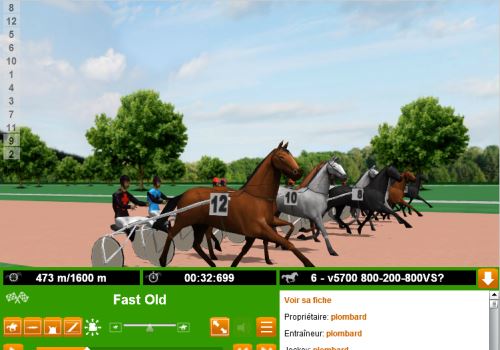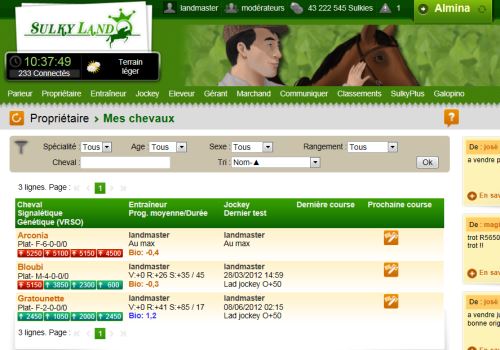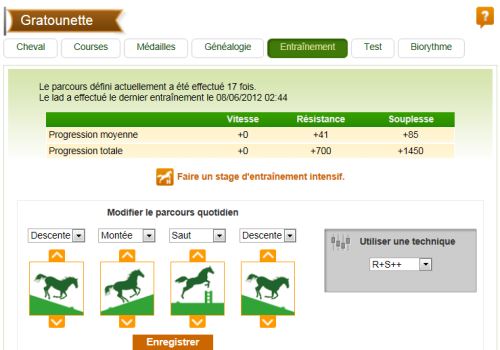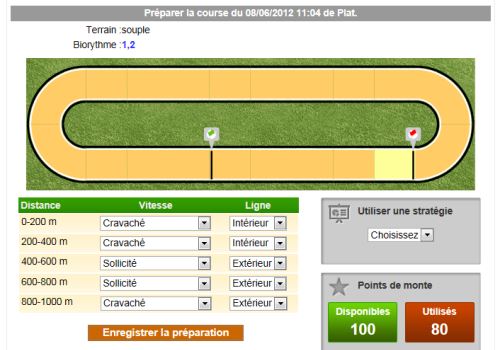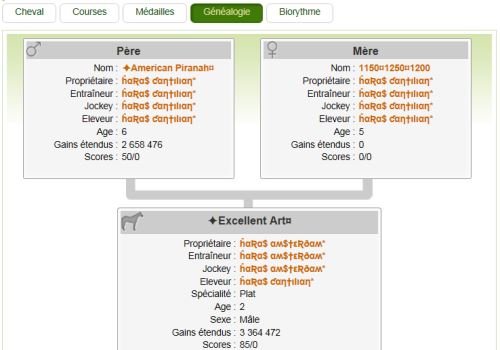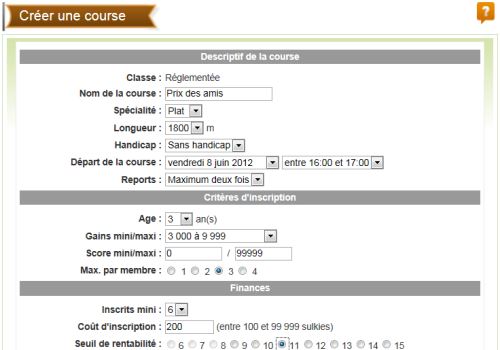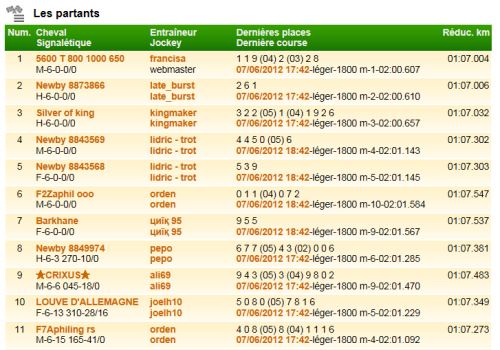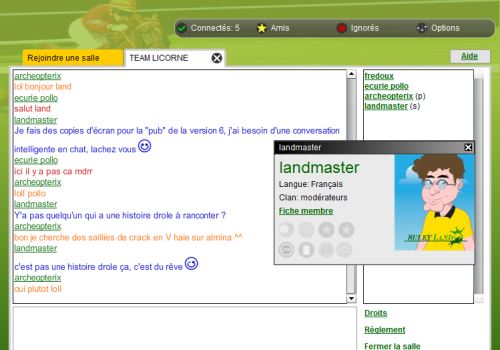Les courses
Races
There are 4 types of races:
- Cups: everyday, the webmaster creates a Cup on his racetrack (Webidrome). These cups permits to win gift points (Gpt).
- Competition: These races are much in demand. There are either official competitions (individual competitions of for clans) or Meetings (individual competitions). The champions of Sulkyland fight every month to win the competition ranking. Competitions are the way to win medals too.
- Reglementary races : they are organized by racecourse managers (see the chapter "Racecourse manager"), but there are nomination's criteria as the earnings, the age or the score of the horse.
- Free races: organized by racecourse managers (see the chapter "Racecourse manager"), they have no restrictions except those chosen by their creators. Races of clan are considered as free races.
There are 3 specialities of races: flat, trot, hurdle. As in real life, hurdle horses can fall and trotting horses can be at fault starting galloping.
The races can be of whatever length between 100 meters and 7100 meters by step of 100 meters.
The weather influences the type of turf. Thanks to the weather forecast, you can know in advance the state of the turf at the time of the race.
There can be from 2 to 20 horses for every race.
You dispose of 15 minutes at least between the limit of inscription and the start of the race to prepare your horse the best possible. Your starting position will be allocated to you when the inscriptions end, thus you can choose the better racing tactic. Jockeys can prepare their race until the last minute before the race.
If there are less entrants than the number set by the racecourse manager, the race is automatically put back 24 hours later, within the limit of the number of postponements remaining.
The winner of a race
A lot of parameters take part in determining who the winner of a race will be.
- Genetics: even if speed is essential, each genetic characteristic has his importance.
- The age: it's recommended to run against horses of the same age.
- The biorhythms: the biorhythm of resistance is important to cover the distance, but the biorhythm of speed (which is hidden on Almina and Bezir) can create real nice or nasty surprises.
- The weather: some horses prefer an heavy turf, others prefer a dry turf...
- Tiredness: don't hold manual tests before races (wait at least 3 hours between each effort of the horse).
- The handicap: if your horse has to wear a supplementary weight, it will be more difficult for him to run as fast as usual. In harness racing, if he has a distance handicap at the start of the race, he will have to be able to catch it.
- Faults and falls: if a horse canters a long while in a trot race, he will be disqualified. In hurdle, it can happen that he misses his jump and falls.
- The jockey's tactic: positioning the horse well on the track to avoid disturbances and losing time in the bends. Using the good quantity of whip points to exploit the best possible the capacities of the horse. The jockey can really make the difference in a race of horses with similar capacities.
The earnings
Free earnings are the earnings obtained in free races or clan races. Some important earnings offered by competitions having very low joining fees are incorporated in the free earnings too.
Reglementary earnings (only on Almina and Bezir) are obtained in reglementary races only.
Extended earnings are obtained in reglementary races and in competitions having a similar policy about joining fees/earnings.
Starting place and handicap
For races without handicap, horses are classified according to their extended earnings (the weakest starts near the rail).
Handicap in trot consists in starting 5 to 25 meters behind the starting line. Horses with handicap are these whose earnings (free earnings for a free race, reglementary earnings for a reglementary race or extended earnings for a competition race) exceed the limit set by the racecourse manager.
Handicap in flat or hurdle consists in carrying a supplementary weight (the horse is slowed down by this weight). This handicap is calculated according to the balanced time (the horse receive 0.5 kg each 1.5 second of difference between his balanced time and the highest balanced time, so the farthermost the horse is from the lower balanced time, the heavier his weight is). So horses having the lower balanced time start near the rail. Horses who never run a race start on the external line and have the maximum handicap. If the balanced time was calculated more than 30 days ago, it's ignored for the handicap calculation and the horse receives the maximum handicap.
The cups
The "cups" are organized and created automatically by the program.
A new cup starts every day. It's named "Coupe - Tour 1" (Cup - 1st round). It can be in any speciality and on any distance with or without handicap and is created by chance.
Horses entering the first round are divided into races taking place each hour. The ten first horses of each race are qualified and automatically enter the next round (Tour 2, Tour 3...) until they are 20 for the final.
There's no joining fees for cups.
Cups' aim is to display your horses (taking part to a high round is a quality assurance for a horse).
On Almina and Bezir, the first 10 horses of a cup's final give Gpts to their owner, trainer, jockey and breeder as following (depending on their rank) :
|
Position |
Owner |
Trainer |
Jockey |
Breeder |
|
1 |
300 |
120 |
120 |
60 |
|
2 |
200 |
80 |
80 |
40 |
|
3 |
150 |
60 |
60 |
30 |
|
4 |
100 |
40 |
40 |
20 |
|
5 |
75 |
30 |
30 |
15 |
|
6 |
50 |
20 |
20 |
10 |
|
7 |
40 |
16 |
16 |
8 |
|
8 |
30 |
12 |
12 |
6 |
|
9 |
20 |
8 |
8 |
4 |
|
10 |
10 |
4 |
4 |
2 |
Gift points can be exchanged for gifts on the page "sulkies balance" - "Use my gift points".
On Chorus, the first 10 horses of a cup's final give sulkies to their owner, trainer, jockey and breeder as following (depending on their rank) :
|
Position |
Owner |
Trainer |
Jockey |
Breeder |
|
1 |
300 000 |
120 000 |
120 000 |
60 000 |
|
2 |
200 000 |
80 000 |
80 000 |
40 000 |
|
3 |
150 000 |
60 000 |
60 000 |
30 000 |
|
4 |
100 000 |
40 000 |
40 000 |
20 000 |
|
5 |
75 000 |
30 000 |
30 000 |
15 000 |
|
6 |
50 000 |
20 000 |
20 000 |
10 000 |
|
7 |
40 000 |
16 000 |
16 000 |
8 000 |
|
8 |
30 000 |
12 000 |
12 000 |
6 000 |
|
9 |
20 000 |
8 000 |
8 000 |
4 000 |
|
10 |
10 000 |
4 000 |
4 000 |
2 000 |
The events
Competitions are organized by players, for players. So the competition organizers are volunteers, who do that to please you, that's why we ask you to show respect and gratitude to them.
If you want to take part to the competitions organization, you can contact the account "compétition-master" by private message. After studying your motivation, he will propose you to participate to a first competition to validate your capacities, and maybe later you will be able to create your own competition if you find an original idea.
Race viewer
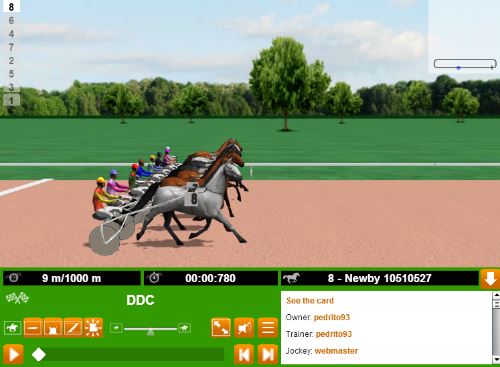
On the left, you can see the list of the runners' numbers, from the first to the last. Clicking on a horse's number, you focus the camera on this horse. Clicking on "Follow the head of the race", the camera will always focus on the horse which is at the first place.
You dispose of 5 different cameras you can select by clicking on their button:
- profile view
- above view
- jockey view
- view from the arrival
- free moving view
In the free moving mode, use the keyboard's arrows or the WASD buttons to move the camera.
The 1 to 5 keys of the keyboard permit to change of camera.
At the right of the camera's buttons, there is a zoom (move the slider to increase or decrease the zoom).
A button displays the viewer in full screen. Beware, this doesn't work with Google chrome currently (we hope they will correct this bug in the future).
There is a button to switch off the sound (music and sound effects). You can choose to change the sound effects definitively from the page "My username" - "My account" - "Change my options".
A button shows the names of the horses near the numbers. In that case it shows a graph at the top right hand corner too, that's a tool we use to finalize the technical adjustments of the viewer.
When you start the viewer, you have nothing special to do to start the race, this is automatic. Once started, you can use the play/pause button to control the broadcasting.
A bar indicates the progress of the race. You can move the slicer to see the part of the race which is interesting you.
The buttons "Behind a picture" and "In front of a picture" allows you to check precise moments of the race (i.e. the arrival).
At the bottom right hand corner, you see information about the selected horse. You can click on the links to open the card of a horse or of his owner, for example. Using the scrollbar, you can see the intermediary times (times every 200 meters). Clicking on the link "intermediary times", a copy is made in the clipboard so you can paste them in an electronic spreadsheet for example.
A button reduces the control bar, like that you can fully enjoy the race.
When starting the viewer, it checks that its technology is in compliance with your computer's capacities. If you see a warning message, you will be taken to a page that explains the solutions you can try to obtain the best of the 3D viewer. If your computer is not able to use the 3D technology, the viewer switch to the 2D mode that allows you to see the race even with an old computer, but you won't be able to use other cameras than the profile camera.
If the raceviewer stays in 3D mode but the video is running jerky, your computer is not enough powerful even if it is compatible with 3D. Go on the page "My username" - "My account" - "Change my options..." and select "Horses 2D" as the value of the option "Race viewer". Then watch the race again.

